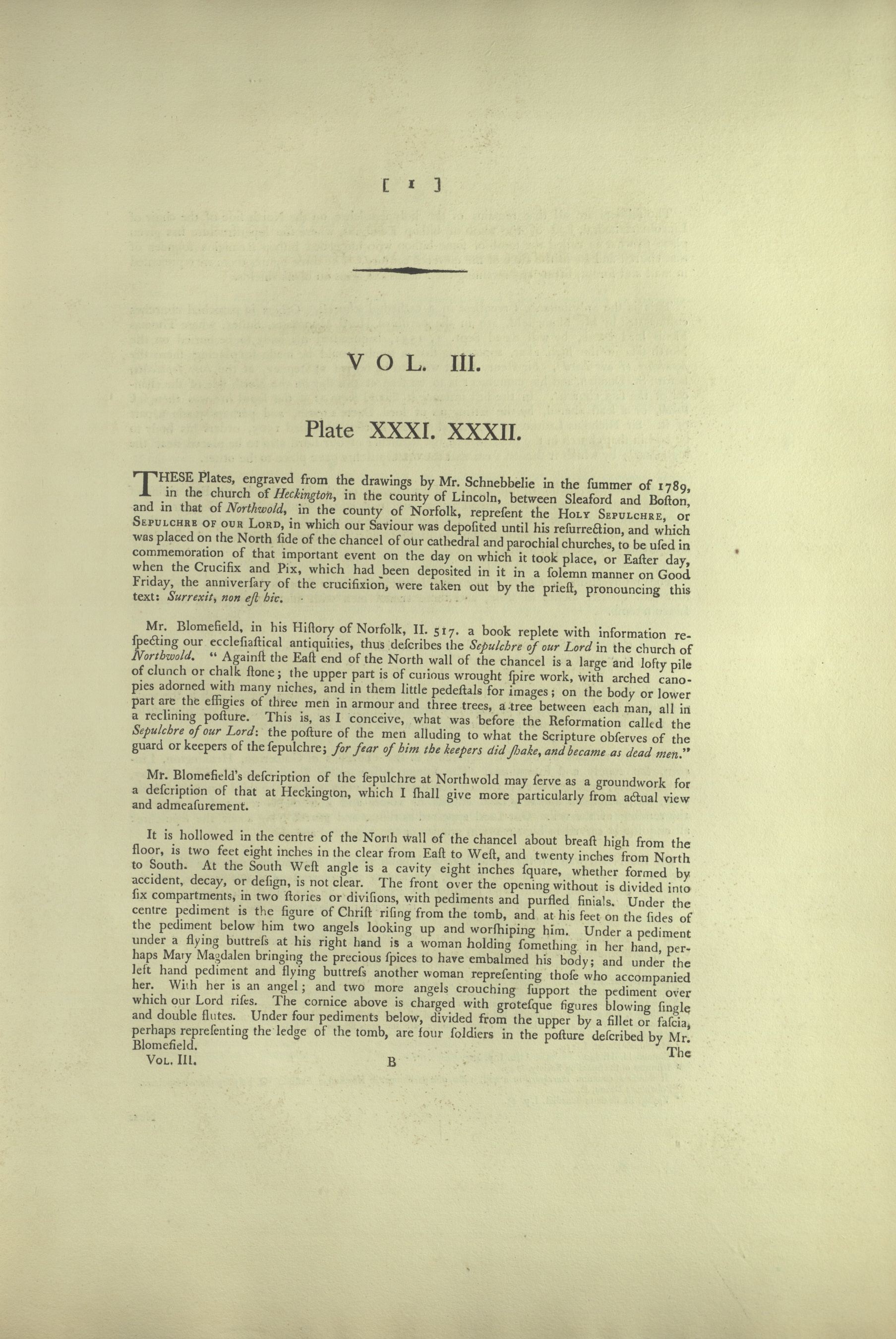
[ (Page) 1 ]
VOL. III.
Plate XXXI. XXXII.
THESE Plates, engraved from the drawings by Mr. Schnebbelie in the summer of 1789, in the church of Heckington, in the county of Lincoln, between Sleaford and Boston, and in that of Northwold, in the county of Norfolk, represent the HOLY SEPULCHRE, or SEPULCHRE OF OUR LORD, in which our Saviour was deposited until his resurrection, and which was placed on the North side of the chancel of our cathedral and parochial churches, to be used in commemoration of that important event on the day on which it took place, or Easter day, when the Crucifix and Pix, which had been deposited in it in a solemn manner on Good Friday, the anniversary of the crucifixion, were taken out by the priest, pronouncing this text: Surrexit, non est hic [He is risen, he is not here].
Read more/less…
Mr. Blomefield, in his History of Norfolk, II. 517. a book replete with information respecting our ecclesiastical antiquities, thus describes the Sepulchre of our Lord in the church of Northwold. “Against the East end of the North wall of the chancel is a large and lofty pile of clunch or chalk stone; the upper part is of curious wrought spire work, with arched canopies adorned with many niches, and in them little pedestals for images; on the body or lower part are the effigies of three men in armour and three trees, a tree between each man, all in a reclining posture. This is, as I conceive, what was before the Reformation called the Sepulchre of our Lord: the posture of the men alluding to what the Scripture observes of the guard or keepers of the sepulcher; for fear of him the keepers did shake, and became as dead men.”
Mr. Blomefield’s description of the sepulchre at Northwold may serve as a groundwork for a description of that at Heckington, which I shall give more particularly from actual view and admeasurement.
It is hollowed in the centre of the North wall of the chancel about breast high from the floor, is two feet eight inches in the clear from East to West, and twenty inches from North to South. At the South West angle is a cavity eight inches square, whether formed by accident, decay, or design, is not clear. The front over the opening without is divided into six compartments, in two stories or divisions, with pediments and purfled finials. Under the centre pediment is the figure of Christ rising from the tomb, and at his feet on the sides of the pediment below him two angels looking up and worshiping him. Under a pediment under a flying buttress at his right hand is a woman holding something in her hand, perhaps Mary Magdalen bringing the precious spices to have embalmed his body; and under the left hand pediment and flying buttress another woman representing those who accompanied her. With her is an angel; and two more angels crouching support the pediment over which our Lord rises. The cornice above is charged with grotesque figures blowing single and double flutes. Under four pediments below, divided from the upper by a fillet or fascia, perhaps representing the ledge of the tomb, are four soldiers in the posture described by Mr. Blomefield.
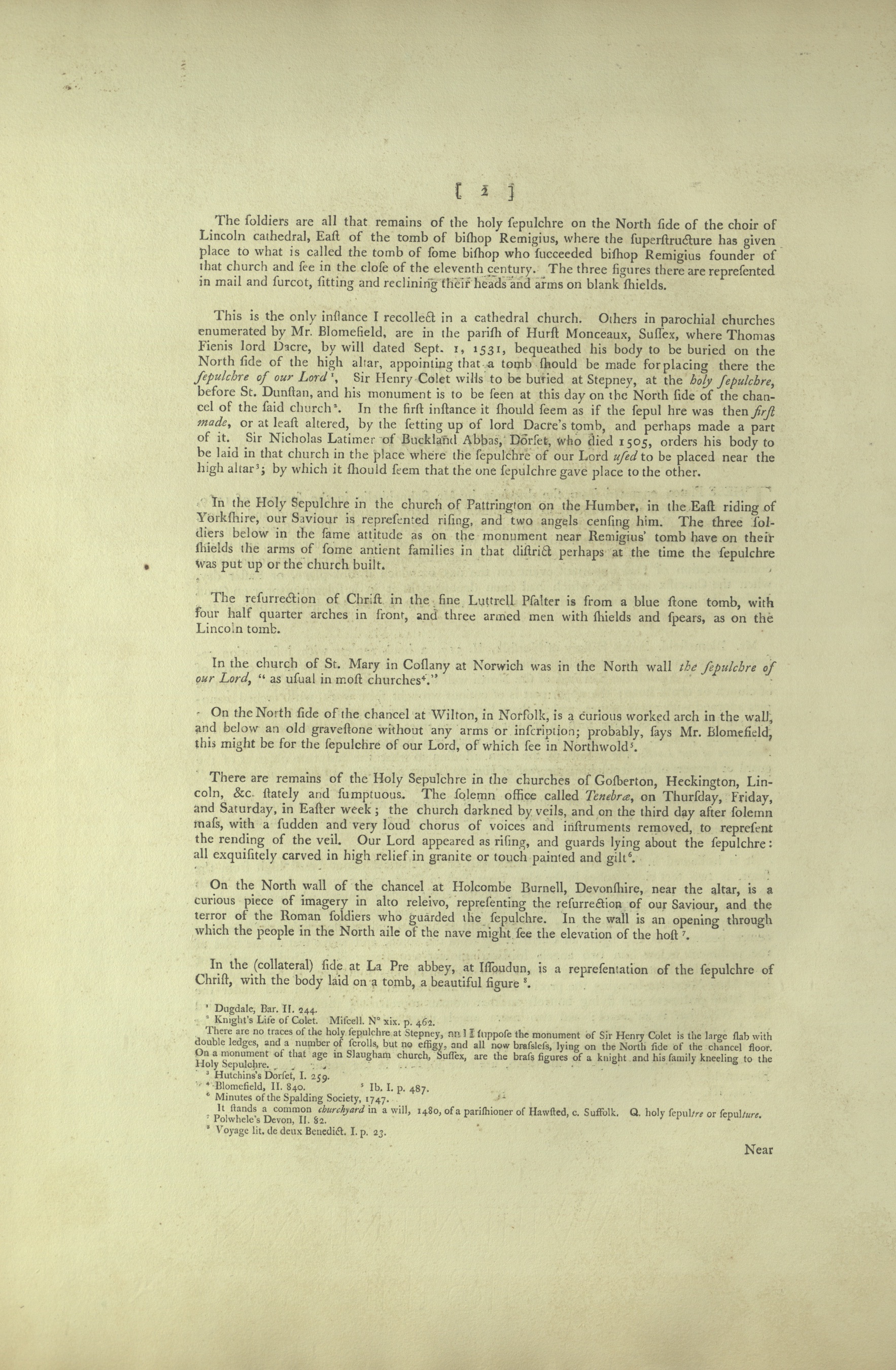
[ (Page) 2]
The soldiers are all that remains of the holy sepulchre on the North side of the choir of Lincoln cathedral, East of the tomb of bishop Remigius, where the superstructure has given place to what is called the tomb of some bishop who succeeded bishop Remigius founder of that church and see in the close of the eleventh century. The three figures there are represented in mail and surcot, sittin and reclining their heads and arms on blank shields.
Read more/less…
This is the only instance I recollect in a cathedral church. Others in parochial churches enumerated by Mr. Blomefield, are in the parish of Hurst Monceaux, Sussex, where Thomas Fienis lord Dacre, by will dated Sept. 1, 1531, bequeathed his body to be buried on the North side of the high altar, appointing that a tomb should be made for placing there the sepulchre of our Lord1, Sir Henry Colet wills to be buried at Stepney, at the holy sepulchre, before St. Dunstan, and his monument is to be seen at this day on the North side of the chancel of the said church2. In the first instance it should seem as if the [sepulchre] was then first made, or at least altered, by the setting up of lord Dacre’s tomb, and perhaps made a part of it. Sir Nicholas Latimer of Buckland Abbas, Dorset, who died 1505, orders his body to be laid in that church in the place where the Sepulchre of our Lord used to be placed near the high altar3; by which it should seem that the one sepulchre gave place to the other.
In the Holy Sepulchre in the church of Pattrington on the Humber, in the East riding of Yorkshire, our Saviour is represented rising, and two angels censing him. The three soldiers below in the same attitude as on the monument near Remigius’ tomb have on their shields the arms of some antient families in that district perhaps at the time the sepulchre was put up or the church built.
The resurrection of Christ in the fine Luttrell Psalter is from a blue stone tomb, with four half quarter arches in front, and three armed men with shields and spears, as on the Lincoln tomb.
In the church of St. Mary in Coslany at Norwich was in the North wall the sepulchre of our Lord, “as usual in most churches4.”
On the North side of the chancel at Wilton, in Norfolk, is a curious worked arch in the wall, and below an old gravestone without any arms or inscription; probably, says Mr. Blomefield, this might be for the sepulchre of our Lord, of which see in Northwold5.
There are remains of the Holy Sepulchre in the churches of Gosberton, Heckington, Lincoln, &c. stately and sumptuous. The solemn office called Tenebrae, on Thursday, Friday, and Saturday, in Easter week; the church darkned by veils, and on the third day after solemn mass, with a sudden and very loud chorus of voices and instruments removed, to represent the rending of the veil. Our Lord appeared as rising, and guards lying about the sepulchre: all exquisitely carved in high relief in granite or touch painted and gilt6.
On the North wall of the chancel at Holcombe Burnell, Devonshire, near the altar, is a curious piece of imagery in alto releivo, representing the resurrection of our Saviour, and the terror of the Roman soldiers who guarded the sepulchre. In the wall is an opening through which the people in the North aile of the nave might see the elevation of the host7.
In the (collateral) side at La Pre abbey, at Issoudun, is a representation of the sepulchre of Christ, with the body laid on a tomb, a beautiful figure8.
1Dugdale, Bar. II. 244.
2Knight’s Life of Colet. Miscell. No xix. p. 462.
There are no traces of the holy sepulchre at Stepney, and I suppose the monument of Sir Henry Colet is the large slab with double ledges, and a number of scrolls, but no effigy, and all now brassless, lying on the North side of the chancel floor. On a monument of that age in Slaugham church, Sussex, are the brass figures of a knight and his family kneeling to the Holy Sepulchre.
3Hutchins’s Dorset, I. 259.
4Blomefield, II. 840.
5Ib. I. p. 487.
6Minutes of the Spalding Society, 1747.
It stands a common churchyard in a will, 1480, of a parishioner of Hawsted, c. Suffolk. Q. holy sepultre or sepulture.
7Polwhele’s Devon, II. 82.
8Voyage lit. de deux Benedict. I. p. 23.
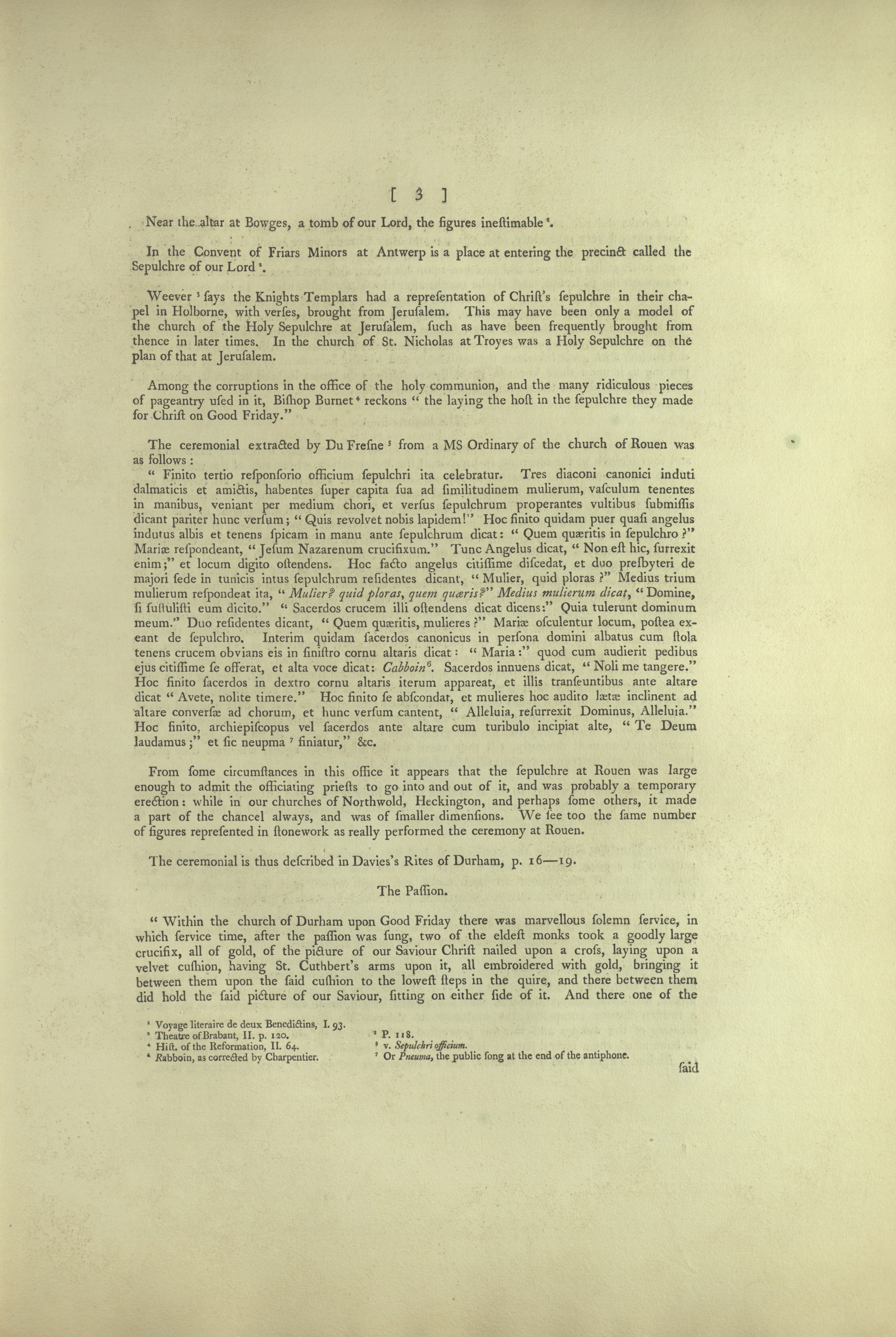
[ (Page) 3 ]
Near the altar at Bowges, a tomb of our Lord, the figures inestimable1.
In the Convent of Friars Minors at Antwerp is a place at entering the precinct called the Sepulchre of our Lord2.
Weever3 says the Knights Templars had a representation of Christ’s sepulchre in their chapel in Holborne, with verses, brought from Jerusalem. This may have been only a model of the church of the Holy Sepulchre at Jerusalem, such as have been frequently brought from thence in later times. In the church of St. Nicholas at Troyes was a Holy Sepulchre on the plan of that at Jerusalem.
Read more/less…
Among the corruptions in the office of the holy communion, and the many ridiculous pieces of pageantry used in it, Bishop Burnet4 reckons “the laying the host in the sepulchre they made for Christ on Good Friday.”
The ceremonial extracted by Du Fresne5 from a MS Ordinary of the church of Rouen was as follows:
“Finito tertio responsorio officium sepulchri ita celebratur. Tres diaconi canonici induti dalmaticis et amictis, habentes super capita sua ad similitudinem mulierum, vasculum tenentes in manibus, veniant per medium chori, et versus sepulchrum properantes vultibus submissis dicant pariter hunc versum; “Quis revolvet nobis lapidem!” Hoc finito quidam puer quasi angelus indutus albis et tenens spicam in manu ante sepulchrum dicat: “Quem quaeritis in sepulchro?” Mariae respondeant, “Jesum Nazarenum crucifixum.” Tunc Angelus dicat, “Non est hic, surrexit enim;” et locum digito ostendens. Hoc facto angelus citissime discedat, et duo presbyteri de majori sede in tunicis intus sepulchrum residentes dicant, “Mulier, quid ploras?” Medius trium mulierum respondeat ita, “Mulier? Quid ploras, quem quaeris?” Medius mulierum dicat, “Domine, si sustulisti eum dicito.” “Sacerdos crucem illi ostendens dicat dicens[: “]Quia tulerunt dominum meum.” Duo residentes dicant, “Quem quaeritis, mulieres?” Mariae osculentur locum, postea exeant de sepulchro. Interim quidam sacerdos canonicus in persona domini albatus cum stola tenens crucem obvians eis in sinistro cornu altaris dicat: “Maria:” quod cum audierit pedibus ejus citissime se offerat, et alta voce dicat: Cabboin6. Sacerdos innuens dicat, “Noli me tangere.” Hoc finito sacerdos in dextro cornu altaris iterum appareat, et illis transeuntibus ante altare dicat “Avete, nolite timere.” Hoc finito se abscondat, et mulieres hoc audito laetae inclinent ad altare conversae ad chorum, et hunc versum cantent, “Alleluia, resurrexit Dominus, Alleluia.” Hoc finito, archiepiscopus vel sacerdos ante altare cum turibulo incipiat alte, “Te Deum laudamus;” et sic neupma7 finiatur,” &c. [see end of document for translation]
From some circumstances in this office it appears that the sepulchre at Rouen was large enough to admit the officiating priests to go into and out of it, and was probably a temporary erection: while in our churches of Northwold, Heckington, and perhaps some others, it made a part of the chancel always, and was of smaller dimensions. We see too the same number of figures represented in stonework as really performed the ceremony at Rouen.
The ceremonial is thus described in Davies’s Rites of Durham, p. 16—19.
The Passion.
“Within the church of Durham upon Good Friday there was marvelous solemn service, in which service time, after the passion was sung, two of the eldest monks took a goodly large crucifix, all of gold, of the picture of our Saviour Christ nailed upon a cross, laying upon a velvet cushion, having St. Cuthbert’s arms upon it, all embroidered with gold, bringing it between them upon the said cushion to the lowest steps in the quire, and there between them did hold the said picture of our Saviour, sitting on either side of it And there one of the
1Voyage literaire de deux Benedictins, I. 93.
2Theatre of Brabant, II. p. 120.
3P. 118.
4Hist. of the Reformation, II. 64.
5v. Sepulchri officium. [v. Office of the Sepulchre]
6Rabboin, as corrected by Charpentier.
7Or Pneuma, the public song at the end of the antiphone.
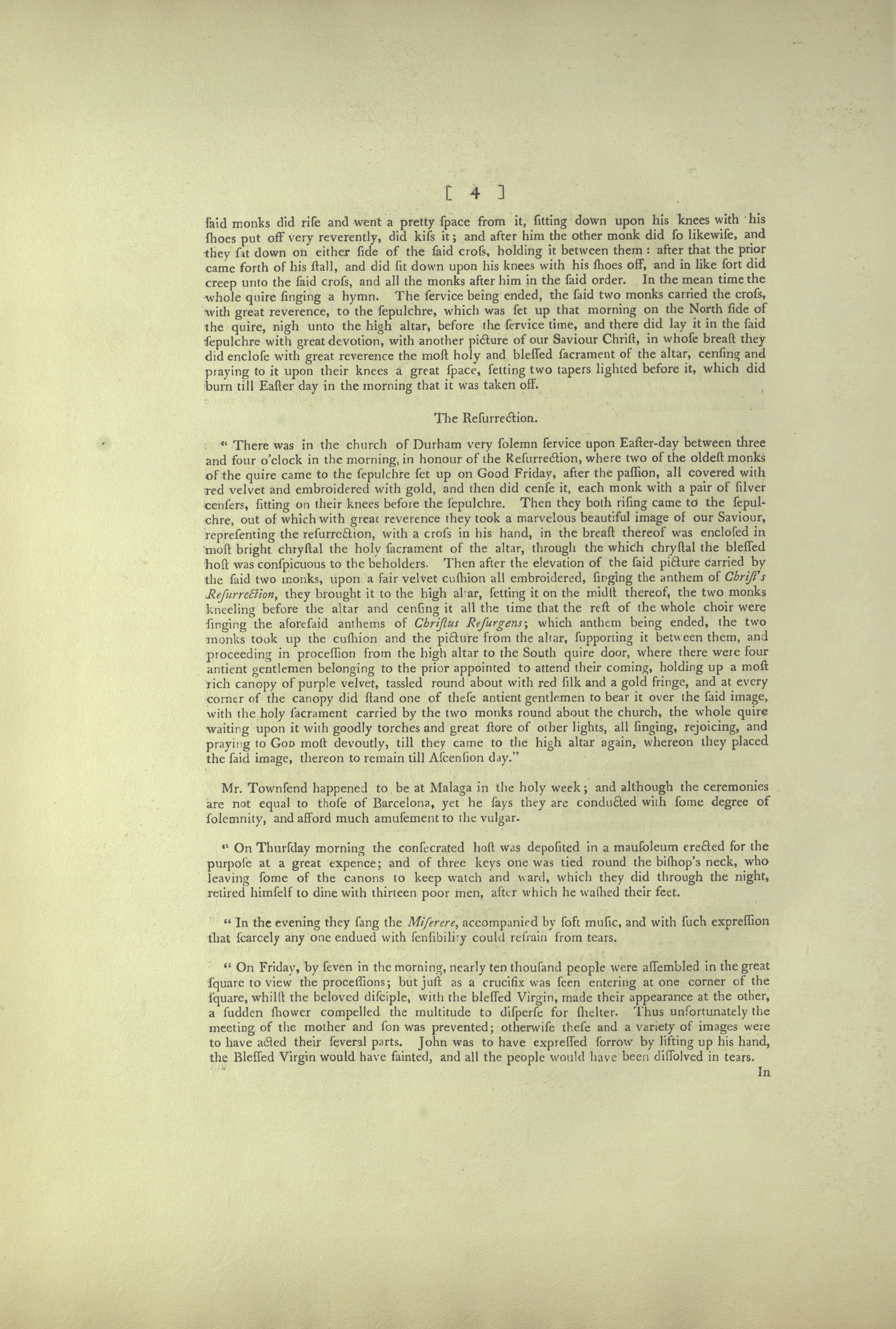
[ (Page) 4 ]
said monks did rise and went a pretty space from it, sitting down upon his knees with his shoes put off very reverently, did kiss it; and after him the other monk did so likewise, and they sat down on either side of the said cross, holding it between them: after that the prior came forth of his stall, and did sit down upon his knees with his shoes off, and in like sort did creep unto the said cross, and all the monks after him in the said order. In the mean time the whole quire singing a hymn.
Read more/less…The service being ended, the said two monks carried the cross, with great reverence, to the sepulchre, which was set up that morning on the North side of the quire, nigh unto the high altar, before the service time, and there did lay it in the said sepulchre with great devotion, with another picture of our Saviour Christ, in whose breast they did enclose with great reverence the most holy and blessed sacrament of the altar, censing and praying to it upon their knees a great space, setting two tapers lighted before it, which did burn till Easter day in the morning that it was taken off.
The Resurrection.
“There was in the church of Durham very solemn service upon Easter-day between three and four o’clock in the morning, in honour of the Resurrection, where two of the oldest monks of the quire came to the sepulchre set up on Good Friday, after the passion, all covered with red velvet and embroidered with gold, and then did cense it, each monk with a pair of silver censers, sitting on their knees before the sepulchre. Then they both rising came to the sepulchre, out of which with great reverence they took a marvelous beautiful image of our Saviour, representing the resurrection, with a cross in his hand, in the breast thereof was enclosed in most bright chrystal the holy sacrament of the altar, through the which chrystal the blessed host was conspicuous to the beholders. Then after the elevation of the said picture carried by the said two monks, upon a fair velvet cushion all embroidered, singing the anthem of Christ’s Resurrection, they brought it to the high altar, setting it on the midst thereof, the two monks kneeling before the altar and censing it all the time that the rest of the whole choir were singing the aforesaid anthems of Christus Resurgens; which anthem being ended, the two monks took up the cushion and the picture from the altar, supporting it between them, and proceeding in procession from the high altar to the South quire door, where there were four antient gentlemen belonging to the prior appointed to attend their coming, holding up a most rich canopy of purple velvet, tassled round about with red silk and a gold fringe, and at every corner of the canopy did stand one of these antient gentlemen to bear it over the said image, with the holy sacrament carried by the two monks round about the church, the whole quire waiting upon it with goodly torches and great store of other lights, all singing, rejoicing, and praying to GOD most devoutly, till they came to the high altar again, whereon they placed the said image, thereon to remain till Ascension day.”
Mr. Townsend happened to be at Malaga in the holy week; and although the ceremonies are not equal to those of Barcelona, yet he says they are conducted with some degree of solemnity, and afford much amusement to the vulgar.
“On Thrusday morning the consecrated host was deposited in a mausoleum erected for the purpose at a great expence; and of three keys one was tied round the bishop’s neck, who leaving some of the canons to keep watch and ward, which they did through the night, retired himself to dine with thirteen poor men, after which he washed their feet.
“In the evening they sang the Miserere, accompanied by soft music, and with such expression that scarcely any one endued with sensibility could refrain from tears.
“On Friday, by seven in the morning, nearly ten thousand people were assembled in the great square to view the processions; but just as a crucifix was seen entering at one corner of the square, whilst the beloved disciple, with the blessed Virgin, made their appearance at the other, a sudden shower compelled the multitude to disperse for shelter. Thus unfortunately the meeting of the mother and son was prevented; otherwise these and a variety of images were to have acted their several parts. John was to have expressed sorrow by lifting up his hand, the Blessed Virgin would have fainted, and all the people would have been dissolved in tears.
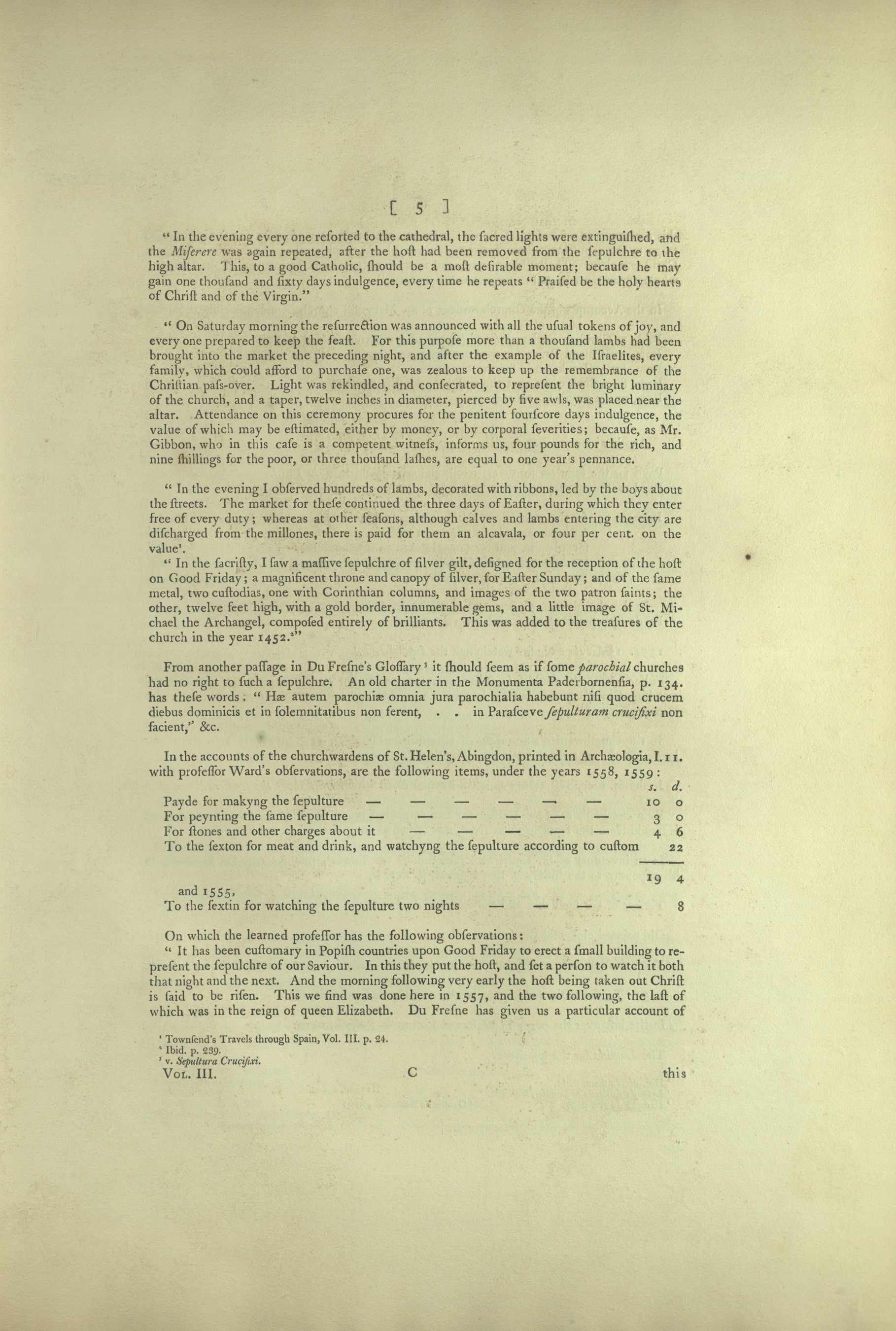
[ (Page) 5 ]
“In the evening every one resorted to the cathedral, the sacred lights were extinguished, and the Miserere was again repeated, after the host had been removed from the sepulchre to the high altar. This, to a good Catholic, should be a most desirable moment; because he may gain one thousand and sixty days indulgence, every time he repeats “Praised be the holy hearts of Christ and of the Virgin.”
Read more/less…
“On Saturday morning the resurrection was announced with all the usual tokens of joy, and every one prepared to keep the feast. For this purpose more than a thousand lambs had been brought into the market the preceding night, and after the example of the Israelites, every family, which could afford to purchase one, was zealous to keep up the remembrance of the Christian pass-over. Light was rekindled, and consecrated, to represent the bright luminary of the church, and a taper, twelve inches in diameter, pierced by five awls, was placed near the altar. Attendance on this ceremony procures for the penitent fourscore days indulgence, the value of which may be estimated, either by money, or by corporal severities; because, as Mr. Gibbon, who in this case is a competent witness, informs us, four pounds for the rich, and nine shillings for the poor, or three thousand lashes, are equal to one year’s pennance.
“In the evening I observed hundreds of lambs, decorated with ribbons, led by the boys about the streets. The market for these continued the three days of Easter, during which they enter free of every duty; whereas at other seasons, although calves and lambs entering the city are discharged from the millones, there is paid for them an alcavala, or four per cent. on the value1.
“In the sacristy, I saw a massive sepulchre of silver gilt, designed for the reception of the host on Good Friday; a magnificent throne and canopy of silver, for Easter Sunday; and of the same metal, two custodias, one with Corinthian columns, and images of the two patron saints; the other, twelve feet high, with a gold border, innumerable gems, and a little image of St. Michael the Archangel, composed entirely of brilliants. This was added to the treasures of the church in the year 1452.2”
From another passage in Du Fresne’ Glossary3 it should seem as if some parochial churches had no right to such a sepulchre. An old charter in the Monumenta Paderbornensia, p. 134. has these words. “Hae autem parochiae omnia jura parochialia habebunt nisi quod crucem diebus dominicis et in solemnitatibus non ferent, . . in Parasceve sepulturam crucifixi non facient,” &c. [These parishes, moreover, will have all the parochial rights, except that they will not carry the cross on Sundays and holidays . . .[and] they will not perform the burial of the crucifix on Good Friday.]
In the accounts of the church wardens of St. Helen’s, Abingdon, printed in Archaeologia, I. II. with professor Ward’s observations, are the following items, under the years 1558, 1559:
s. d.
Payde for makyng the sepulture10 0
For peynting the same sepulture 3 0
For stones and other charges about it 4 6
To the sexton for meat and drink, and watchyng the sepulture according to custom 22
19 4
And 1555,
To the sextin for watching the sepulture two nights 8
On which the learned professor has the following observations:
“It has been customary in Popish countries upon Good Friday to erect a small building to represent the sepulchre of our Saviour. In this they put the host, and set a person to watch it both that night and the next. And the morning following very early the host being taken out Christ is said to be risen. This we find was done here in 1557, and the two following, the last of which was in the reign of queen Elizabeth. Du Fresne has given us a particular account of
1Townsend’s Travels through Spain, Vol. III. p. 24.
2Ibid. p. 239.
3 v. Sepultura Crucifixi. [v. Burial of the Crucifix]
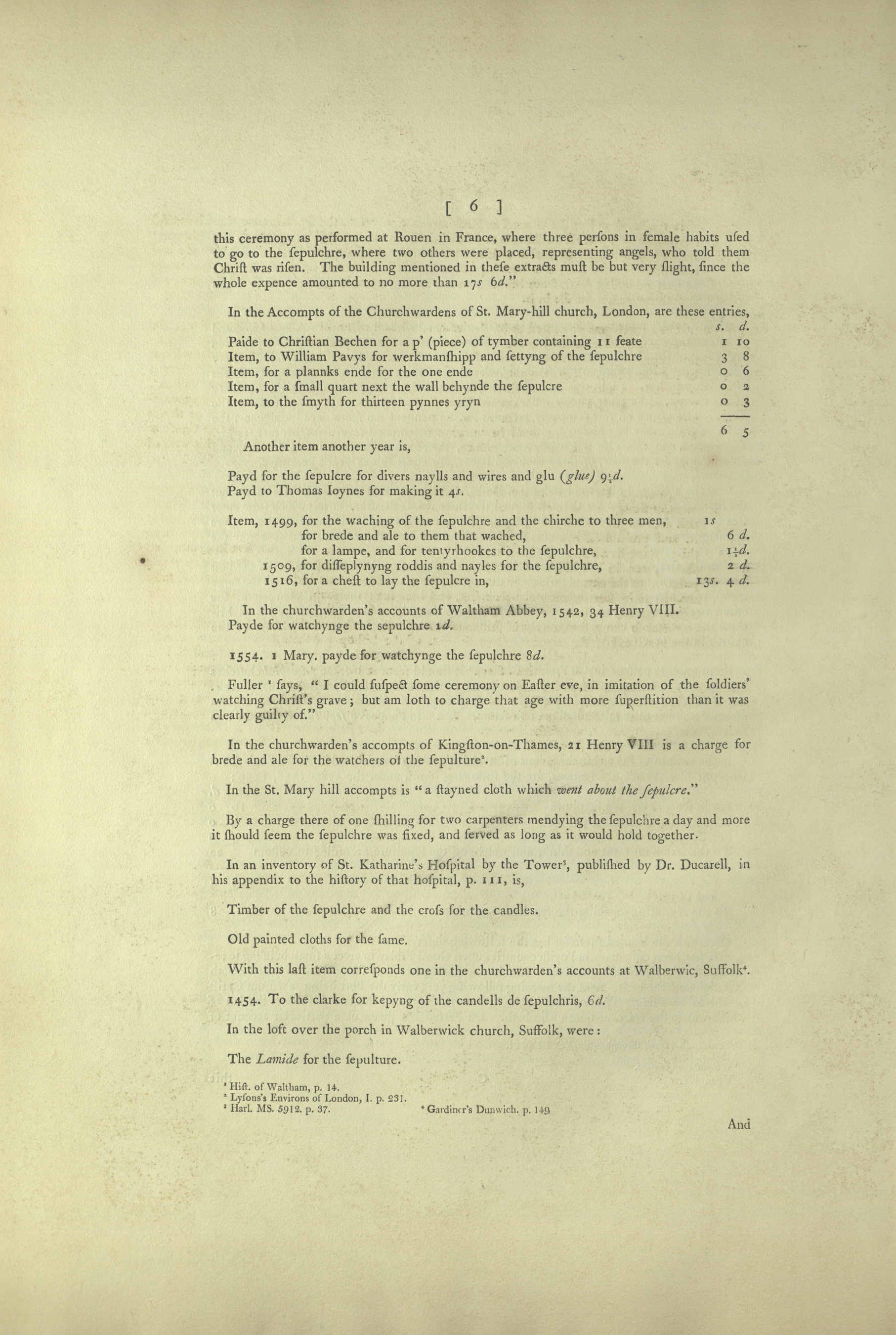
[ (Page) 6 ]
this ceremony as performed at Rouen in France, where three persons in female habits used to go to the sepulchre, where two others were placed, representing angels, who told them Christ was risen. The building mentioned in these extracts must be but very slight, since the whole expence amounted to no more than 17s 6d.”
Read more/less…
In the Accompts of the Churchwardens of St. Mary-hill church, London, are these entries,
s. d.
Paide to Christian Bechen for a p’ (piece) of tymber containing 11 feate1 10
Item, to William Pavys for werkmanshipp and settyng of the sepulchre3 8
Item, for a plannks ende for the one ende0 6
Item, for a small quart next the wall behynde the sepulcre0 2
Item, to the smyth for thirteen pynnes yryn0 3
Another item another year is,
Payd for the sepulcre for divers naylls and wires and glu (glue) 9½ d.
Payd to Thomas Ioynes for making it 4s.
Item, 1499, for the waching of the sepulchre and the chirche to three men,1s.
for brede and ale to them that wached,6d.
for a lampe, and for tentyrhookes to the sepulchre,1½d.
1509, for disseplynyng roddis and nayles for the sepulchre, 2d.
1516, for a chest to lay the sepulchre in, 13s. 4d.
In the churchwarden’s accounts of Waltham Abbey, 1542, 34 Henry VIII.
Payde for watchynge the sepulchre 1d.
1554. I Mary. payde for watchynge the sepulchre 8d.
Fuller1 says, “I could suspect some ceremony on Easter eve, in imitation of the soldiers’ watching Christ’s grave; but am loth to charge that age with more superstition than it was clearly guilty of.”
In the churchwarden’s accompts of Kingston-on-Thames, 21 Henry VIII is a charge for brede and ale for the watchers of the sepulture2.
In the St. Mary hill accompts is “a stayned cloth which went about the sepulcre.”
By a charge there of one shilling for two carpenters mendying the sepulchre a day and more it should seem the sepulchre was fixed, and served as long as it would hold together.
In an inventory of St. Katharine’s Hospital by the Tower3, published by Dr. Ducarell, in his appendix to the history of that hospital, p. 111, is,
Timber of the sepulchre and the cross for the candles.
Old painted cloths for the same.
With this last item corresponds one in the churchwarden’s accounts at Walberwic, Suffolk4.
1454. To the clarke for kepyng of the candells de sepulchris, 6d.
In the loft over the porch in Walberwick church, Suffolk, were:
The Lamide for the sepulture.
1Hist. of Waltham, p. 14.
2Lyson’s Environs of London, I. p. 231.
3Harl. MS. 5912. p. 37.
4Gardiner’s Dunwich. P.149
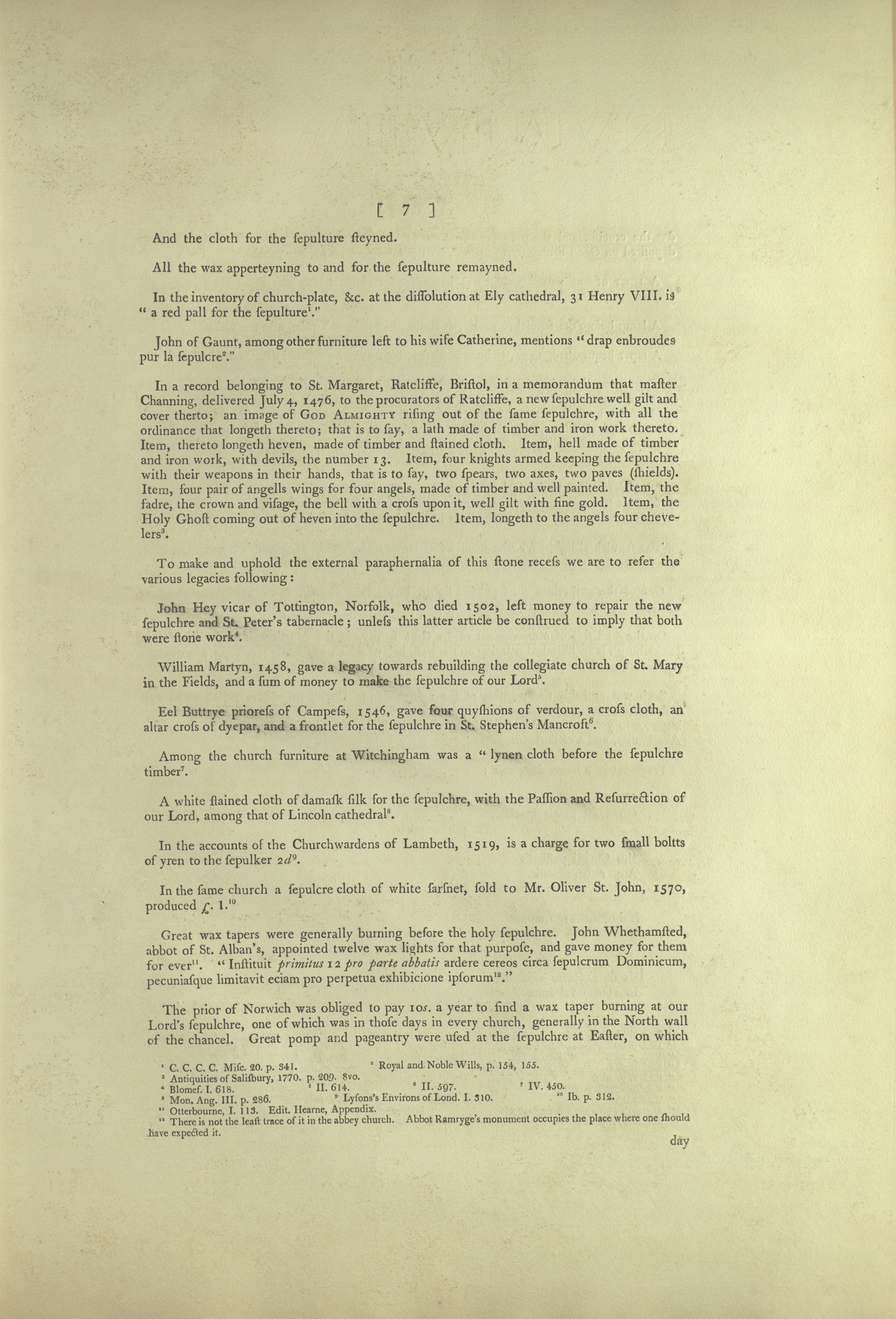
[ (Page) 7 ]
And the cloth for the sepulture steyned.All the wax apperteyning to and for the sepulture remayned.
In the inventory of church-plate, &c. at the dissolution at Ely cathedral, 31 Henry VIII. is “a red pall for the sepulchre1.”
John of Gaunt, among other furniture left to his wife Catherine, mentions “drap enbroudes pur la sepulcre2.” [embroidered cover for the sepulchre]
Read more/less…
In a record belonging to St. Margaret, Ratcliffe, Bristol, in a memorandum that master Channing, delivered July 4, 1476, to the procurators of Ratcliffe, a new sepulchre well gilt and cover therto; an image of GOD ALMIGHTY rising out of the same sepulchre, with all the ordinance that longeth thereto; that is to say, a lath made of timber and iron work thereto. Item, thereto longeth heven, made of timber and stained cloth. Item, hell made of timber and iron work, with devils, the number 13. Item, four knights armed keeping the sepulchre with their weapons in their hands, that is to say, two spears, two axes, two paves (shields). Item, four pair of angells wings for four angels, made of timber and well painted. Item, the fadre, the crown and visage, the bell with a cross upon it, well gilt with fine gold. Item, the Holy Ghost coming out of heven into the sepulchre. Item, longeth to the angels four chevelers3.
To make and uphold the external paraphernalia of this stone recess we are to refer the various legacies following:
John Hey vicar of Tottington, Norfolk, who died 1502, left money to repair the new sepulchre and St. Peter’s tabernacle; unless this latter article be construed to imply that both were stone work4.
William Martyn, 1458, gave a legacy towards rebuilding the collegiate church of St. Mary in the Fields, and a sum of money to make the sepulchre of our Lord5.
Eel Buttrye prioress of Campess, 1546, gave four quyshions of verdour, a cross cloth, an altar cross of dyepar, and a frontlet for the sepulchre in St. Stephen’s Mancroft6.
Among the church furniture at Witchingham was a “lynen cloth before the sepulchre timber7.[”]
A white stained cloth of damask silk for the sepulchre, with the Passion and Resurrection of our Lord, among that of Lincoln cathedral8.
In the accounts of the Churchwardens of Lambeth, 1519, is a charge for two small boltts of yren to the sepulker 2d9.
In the same church a sepulcre cloth of white farsnet, sold to Mr. Oliver St. John, 1570, produced £. 1.10
Great wax tapers were generally burning before the holy sepulchre. John Whethamsted, abbot of St. Alban’s, appointed twelve wax lights for that purpose, and gave money for them for ever11. “Instituit primitus 12 pro parte abbatis ardere cereos circa sepulcrum Dominicum, pecuniasque limitavit eciam pro perpetua exhibicione ipsorum12.”
The prior of Norwich was obliged to pay 10s. a year to find a wax taper burning at our Lord’s sepulchre, one of which was in those days in every church, generally in the North wall of the chancel. Great pomp and pageantry were used at the sepulchre at Easter, on which
1C. C. C. C. Misc. 20. p. 341.
2Royal and Noble Wills, p. 154, 155.
3Antiquities of Salisbury, 1770. p. 209. 8vo.
4Blomes. I. 618.
5II. 614.
6II. 597.
7IV. 450.
8Mon Ang. III. P. 286.
9Lyson’s Environs of Lond. I. 310.
10Ib. p. 312.
11Otterbourne, I. 113. Edit. Hearne, Appendix.
12There is not the least trace of it in the abbey church. Abbot Ramryge’s monument occupies the place where one should have expected it. [The Latin quotation is a version of the preceding English sentence.]
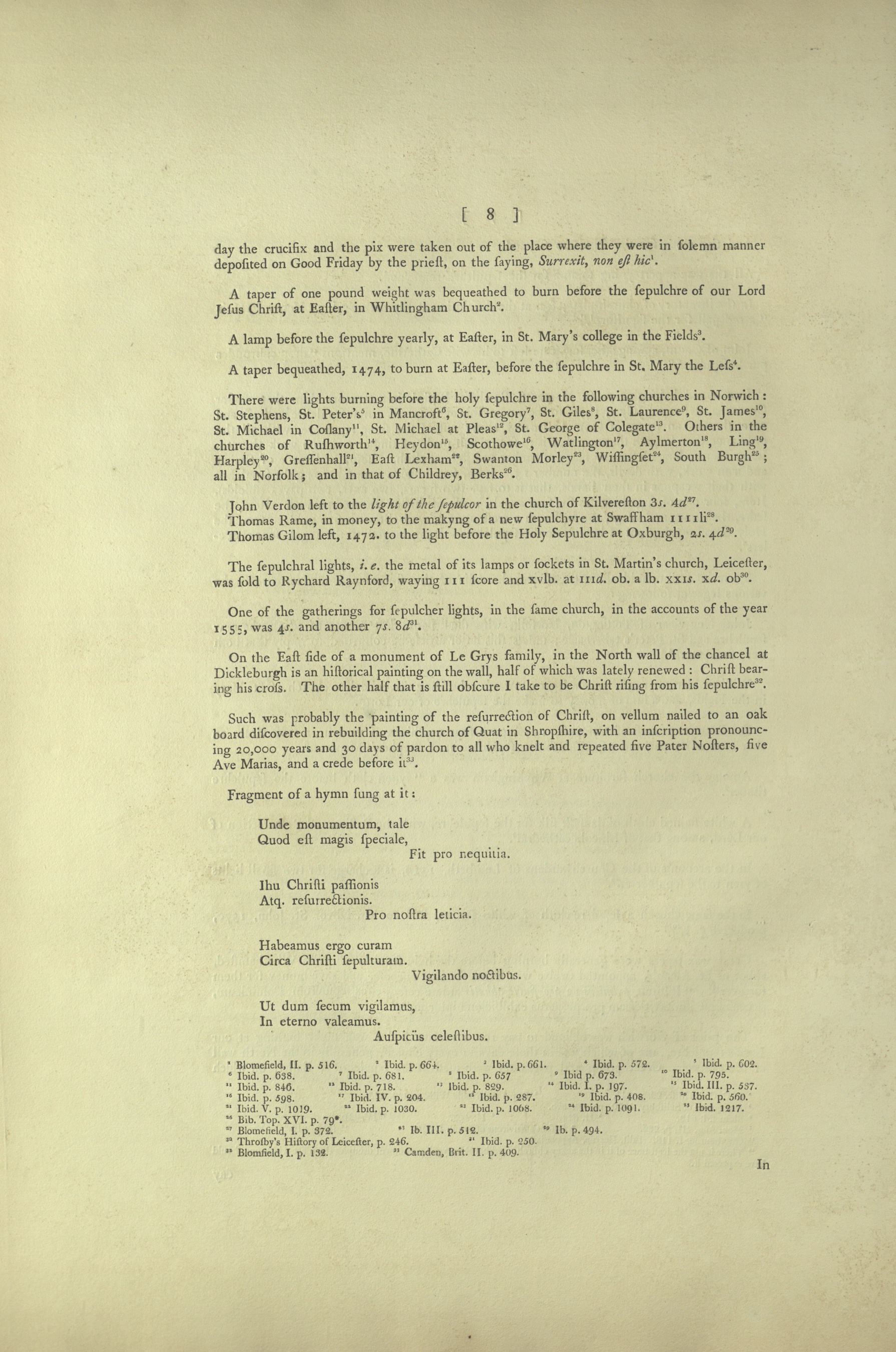
[ (Page) 8 ]
day the crucifix and the pix were taken out of the place where they were in solemn manner deposited on Good Friday by the priest, on the saying, Surrexit, non est hic [He is risen, he is not here]1.
A taper of one pound weight was bequeathed to burn before the sepulchre of our Lord Jesus Christ, at Easter, in Whitlingham Church2.
Read more/less…
A lamp before the sepulchre yearly, at Easter, in St. Mary’s college in the Fields3.
A taper bequeathed, 1474, to burn at Easter, before the sepulchre in St. Mary the Less4.
There were lights burning before the holy sepulchre in the following churches in Norwich: St. Stephens, St. Peter’s5 in Mancroft6, St. Gregory7, St. Giles8, St. Laurence9, St. James10, St. Michael in Coslany11, St. Michael at Pleas12, St. George of Colegate13. Others in the churches of Rushworth14, Heydon15, Scothowe16, Watlington17, Aylmerton18, Ling19, Harpley20, Gressenhall21, East Lexham22, Swanton Morley23, Wissingset24, South Burgh25; all in Norfolk; and in that of Childrey, Berks26.
John Verdon left to the light of the sepulcor in the church of Kilvereston 3s. 4d27.
Thomas Rame, in money, to the makyng of a new sepulchyre at Swaffham 1111li28.
Thomas Gilom left, 1472. to the light before the Holy Sepulchre at Oxburgh, 2s. 4d29.
The sepulchral lights, i.e. the metal of its lamps or sockets in St. Martin’s church, Leicester, was sold to Rychard Raynford, waying III score and XVlb. at IIId. ob. a lb. XXIs. Xd. ob30.
One of the gatherings for sepulcher lights, in the same church, in the accounts of the year 1555, was 4s. and another was 7s. 8d31.
On the East side of a monument of Le Grys family, in the North wall of the chancel at Dickleburgh is an historical painting of the wall, half of which was lately renewed: Christ bearing his cross. The other half that is still obscure I take to be Christ rising from his sepulchre32.
Such was probably the painting of the resurrection of Christ, on vellum nailed to an oak board discovered in rebuilding the church of Quat in Shropshire, with an inscription pronouncing 20,000 years and 30 days of pardon to all who knelt and repeated five Pater Nosters, five Ave Marias, and a crede before it33.
Fragment of a hymn sung at it:
Unde monumentum, tale
Quod est magis speciale,
Fit pro nequitia.
Ihu Christi passionis
Atq. resurrectionis.
Pro nostra leticia.
Habeamus ergo curam
Circa Christi sepulturam.
Vigilando noctibus.
Ut dum secum vigilamus,
In eterno valeamus.
Auspicüs celestibus.
[Whence a monument, such as is more special, becomes regarded as worthless. Of the passion and resurrection of Jesus Christ. For our happiness. Let us, therefore, take care of the burial of Christ. By keeping watch at nights. So that so long as we keep watch with him, we may be well for eternity. Under celestial auspices.]
1Blomefield, II. p. 516.
2Ibid. p. 664.
3Ibid. p. 661.
4Ibid. p. 572.
5Ibid. p. 602.
6Ibid. p. 638.
7Ibid. p. 681.
8Ibid. p. 657.
9Ibid. p. 673.
10Ibid. p. 795.
11Ibid. p. 846.
12Ibid. p. 718.
13Ibid. p. 829.
14Ibid. I. p. 197.
15Ibid. III. p. 537.
16Ibid. p. 598.
17Ibid. IV. p. 204.
18Ibid. p. 287.
19Ibid. p. 408.
20Ibid p. 560.
21Ibid. V. p. 1019.
22Ibid. p. 1030.
23Ibid. p. 1068.
24Ibid. p. 1091.
25Ibid. 1217.
26Bib. Top. XVI. p. 79*.
27Blomefield, I. p. 372.
28Ib. III. P. 512.
29Ibid. p. 494.
30Throsby’s History of Leicester, p. 246.
31Ibid. p. 250.
32Blom[e]field, I. p. 132.
33Camden, Brit. II. p. 409.
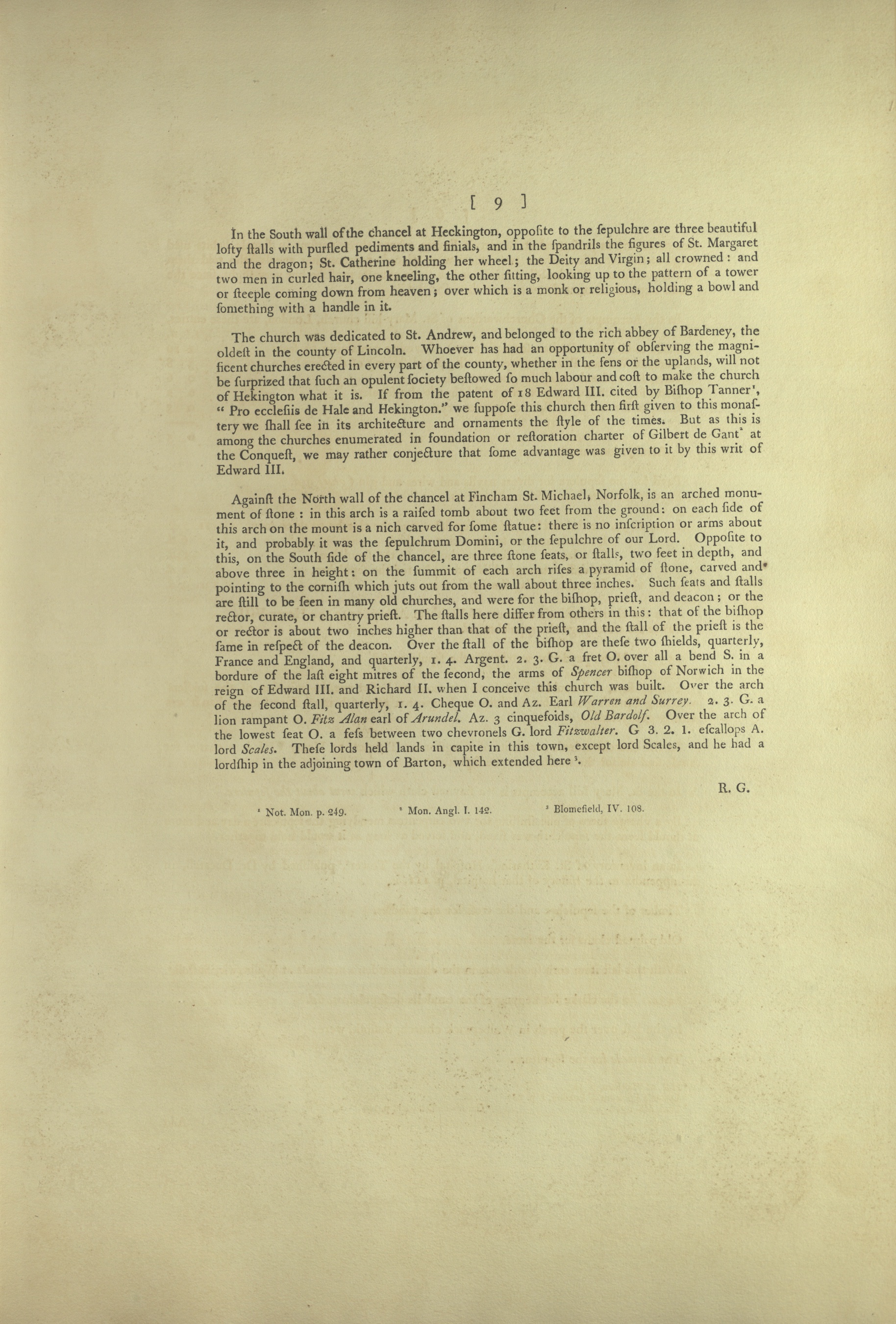
[ (Page) 9 ]
In the South wall of the chancel at Heckington, opposite to the sepulchre are three beautiful lofty stalls with purfled pediments and finials, and in the spandrils the figures of St. Margaret and the dragon; St. Catherine holding her wheel; the Deity and Virgin; all crowned: and two men in curled hair, one kneeling, the other sitting, looking up to the pattern of a tower or steeple coming down from heaven; over which is a monk or religious, holding a bowl and something with a handle in it.
Read more/less…
The church was dedicated to St. Andrew, and belonged to the rich abbey of Bardeney, the oldest in the county of Lincoln. Whoever has had an opportunity of observing the magnificent churches erected in every part of the county, whether in the fens or the uplands, will not be surprized that such an opulent society bestowed so much labour and cost to make the church of He[c]kington what it is. If from the patent of 18 Edward III. cited by Bisho Tanner1, “Pro ecclesiis de Hale and Hekington. [For the churches of Hale and Hekington.]” we suppose this church then first given to this monastery we shall see in its architecture and ornaments the style of the times. But as this is among the churches enumerated in foundation or restoration charter of Gilbert de Gant2 at the Conquest, we may rather conjecture that some advantage was given to it by this writ of Edward III.
Against the North wall of the chancel at Fincham St. Michael, Norfolk, is an arched monument of stone: in this arch is a raised tomb about two feet from the ground: on each side of this arch on the mount is a nich carved for some statue: there is no inscription or arms about it, and probably it was the sepulcrum Domini, or the sepulchre of our Lord. Opposite to this, on the South side of the chancel, are three stone seats, or stalls, two feet in depth, and above three in height: on the summit of each arch rises a pyramid of stone, carved and pointing to the cornish which juts out from the wall about three inches. Such seats and stalls are still to be seen in many old churches, and were for the bishop, priest, and deacon; or the rector, curate, or chantry priest. The stalls here differ from others in this: that of the bishop or rector is about two inches higher than that of the priest, and the stall of the priest is the same in respect of the deacon. Over the stall of the bishop are these two shields, quarterly, France and England, and quarterly, 1. 4. Argent. 2. 3. G. a fret O. over all a bend S. in a bordure of the last eight mitres of the second, the arms of Spencer bishop of Norwich in the reign of Edward III. and Richard II. when I conceive this church was built. Over the arch of the second stall, quarterly, 1. 4. Cheque O. and AZ. Earl Warren and Surrey. 2. 3. G. a lion rampant O. Fitz Alan earl of Arundel. AZ. 3 cinqufoids, Old Bardolf. Over the arch of the lowest seat O. a fess between two chevronels G. lord Fitzwalter. G 3. 2. 1. escallops A. lord Scales. These lords held lands in capite in this town, except lord Scales, and he had a lordship in the adjoining town of Barton, which extended here3.
R[ichard]. G[ough].
1Not. Mon. p. 249.
2Mon. Angl. I. 142.
3Blomefield, IV. 108.
Translations of the Longer Passage:
Page 3, line 14: Once the third response is done, the office of the sepulchre is performed as follows. Three canon deacons dressed in dalmatics and amices, having over their heads [attire] in the manner of women, holding a little vessel in their hands, should come through the middle of the choir and, hurrying toward the sepulchre, heads bowed, say in unison this verse: ‘Who will roll back the stone for us?’ Once this is done, a child, like an angel, dressed in white and holding in his hand a wand [lit. “ear of grain”] should say before the sepulchre: ‘Whom do you seek in the sepulchre?’ The Marys should answer, ‘the crucified Jesus of Nazareth’. Then the angel should say, ‘He is not here, for he is risen;’ also pointing out the place with his finger. After this, the angel should depart in haste, and two priests from the higher seat, wearing tunics and sitting in the sepulchre, should say, ‘woman, why do you weep, whom do you seek?’ The middle of the three women should say, “Lord, say if you have taken him up.’ The priest, showing her the cross, should speak, saying: ‘Because they have taken my lord.’ The two seated should say, ‘whom do you seek, women?’ The Marys should kiss the place and then leave the sepulchre. Meanwhile a canon priest in alb and stole, playing the role of the Lord, holding a cross and meeting them at the left corner of the altar, should say: ‘Mary’. And when she hears that, she should quickly fall [lit. “offer herself”] at his feet and in a loud voice say: ‘Cabboin’. The priest restraining her [lit. “nodding no”] should say: ‘Do not touch me.’ Once this is done, the priest should appear again at the right corner of the altar and say to those passing before the altar ‘Hail, fear not.’ Once this is done, he should hide himself, and the women, happy upon hearing this, should bow toward the altar, turning toward the choir, and sing this verse, “Hallelujah, the Lord is risen, Hallelujah.” Once this is done, the archbishop or priest [standing] before the altar with a thurible should begin aloud, ‘We praise you God’, and in this way the pneuma should conclude, etc.”
See also: E. Trollope, Sleaford and the Wapentakes of Flaxwell and Aswardhurn in the County of Lincoln (1872), p. 394.









